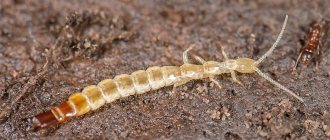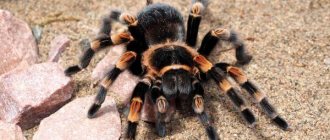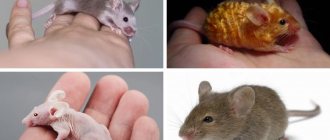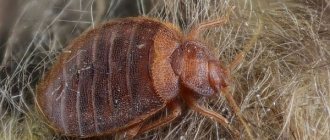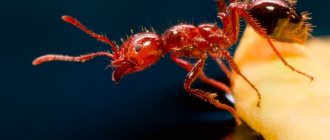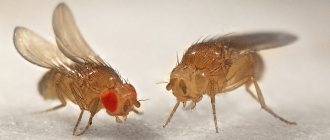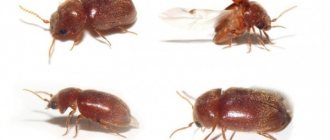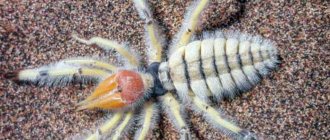Appearance
The graceful ground beetle has a body on which the head, chest and abdomen are oval in shape. The length of the beetle sometimes reaches 52 mm. This insect cannot fly - its wings are undeveloped, but its long legs allow it to run quite quickly. The front legs are adapted for cleaning the antennae due to the presence of a notch with dense hairs.
The Crimean ground beetle (photos of its representatives can be seen in the article) has several forms, differing in color, which can be blue, purple, green or black. The light on the surface of the coarse, wrinkled coatings is refracted, resulting in the illusion of the insect changing color. Experts call this feature optical coloring. The lower part of the ground beetle's body is black, with a shiny metallic tint.
Sexual demorphism is weakly expressed. Females are slightly larger, and males can be distinguished by their longer antennae and extended forelegs. The lifespan of these insects is 10-11 years.
Limiting factors and threats
Stenotopic, local and very small species, not found in many externally suitable biogeocenoses. Perhaps its depressed state in the region is due to increased sensitivity to even moderate disturbances of the established structures of old forest ecosystems. The species is vulnerable primarily to forest disturbances as a result of logging, fires, as well as destruction and trampling of soil cover, and regular overgrazing. Possibly vulnerable to man-made pollution. Isolated coenopopulations may be in danger of degeneration.
Features of behavior
The Crimean ground beetle is a predator that most often leads a nocturnal lifestyle. Occasionally, it may appear during the day in search of food. Muscular long legs help hunt prey. With their help, the beetle also escapes from enemies. In one night, the insect can cover a distance of up to 2 km. At the same time, he has to maneuver to get to the most vulnerable spot of the victim. It is very difficult to catch a ground beetle - it is so evasive and fast.
When it is not possible to escape from the enemy with the help of its legs, it releases from its abdomen a stream of caustic brown liquid with an unpleasant, pungent odor. The formic acid contained in its composition causes severe pain and lacrimation if it gets into the eyes.
Lifestyle and interesting facts about the Crimean ground beetle
The Crimean ground beetle is endemic to the Crimean peninsula.
Insects of this species are both diurnal and nocturnal. They feed on animal organisms. The main delicacy for the Crimean ground beetle is the grape snail. But the diet also includes other shellfish.
To feast on the meat of a mollusk, the ground beetle does not break the shell, but simply “sucks out” the body of the mollusk. When the ground beetle is completely saturated, it can burrow into the ground and remain motionless for several days. The endurance of the insect and its method of hunting deserve special attention. Thanks to its strong legs, the ground beetle can run about two kilometers in a night in search of prey!
The ground beetle can have different shades: from blue to black, including purple and green.
If the insect senses danger, it can release a sharp, caustic substance. For people, getting this composition into the eyes can cause conjunctivitis. This advantage makes the ground beetle not a very pleasant prey for birds and animals, so larger predators try to avoid this beetle. This applies to foxes, raccoon dogs, badgers and some birds.
Most often, ground beetles can be found in parks and gardens, where they spend time burrowing into fallen leaves. Sometimes these insects simply crawl along the ground, going about their daily business.
The ground beetle has no enemies in nature, thanks to its defense mechanism.
Ground beetles are considered one of the most useful beetles for agriculture. They are capable of eating harmful insects, such as silkworms, which annually cause massive damage to farmland. For this purpose, people specially release ground beetles into the fields.
Nutrition
Like most representatives of this family, the Crimean ground beetle has extraintestinal digestion. Holding its prey with its powerful jaws, the beetle practically sucks it in. The midgut secretions poured onto the victim help soften even the toughest tissues. Strong jaws easily destroy any chitinous cover.
The basis of the diet of ground beetles are caterpillars, slugs, snails, other beetles, and insect eggs. The predator can lie in wait for its prey in ambush or catch up with the help of long muscular legs. When eating a snail, the beetle leaves its house intact, gnawing only the mollusk itself. Having had enough, the Crimean ground beetle burrows into the soil for several days.
How to deal with ground beetle pest
A harmful ground beetle, how to get rid of an insidious predator - this question is relevant among many gardeners. Damage from insects brings trouble not only to agricultural areas, but also to homes, into which annoying beetles manage to penetrate.
An integrated approach with agrotechnical and chemical measures, with quick harvesting without grain spillage, contributes to maximum protection from the pest.
Black ground beetles in the home are not a common and unpleasant occurrence. Their stay in the apartment is not long due to lack of food. However, they are capable of infecting entire premises with larvae. Obvious factors for the spread of domestic beetles are:
- food products: flour, cereals, potatoes, etc.;
- food waste;
- garbage;
- firewood;
- old wood.
Taking immediate action to eliminate insects will help eliminate large-scale infestations. In the fight against beetles, the following are considered effective means:
- general cleaning with a thorough search for their location;
- treating surfaces with solutions of baking soda or vinegar;
- use of insecticidal preparations against insects;
- protective mesh on windows.
It is also necessary to monitor the safety of food products when sealed. Most ground beetle species reach large numbers and are of significant importance in the natural and anthropogenic ecosystem. Insects are indicators of the state of the surrounding space and the presence of pollution introduced by humans.
Reproduction
Mating usually occurs in April. After this, the female lays eggs directly into the ground. Their depth is approximately 30 mm. There they remain for 13 to 14 days, after which larvae are born up to 19 mm in length and weighing about 160 mg. They have 6 claw-shaped short legs on their body. At first the larvae are white in color, but 10 hours after hatching they turn purple-black.
From birth they already have the powerful jaws of a predator. They feed on terrestrial mollusks, tightly clinging to them. The victim, resisting, covers the larva with mucus and foam, but it stubbornly fights off with its legs, burrowing into the soil and turning its shell towards itself. Then it gradually penetrates into it and eats the mollusk. By the end of summer, the development of the larvae is completed, it pupates and overwinters as an adult. This stage lasts from 2 to 3 years.
Characteristics and body structure
The sizes of ground beetles range from 3 to 60 mm. Unlike other beetles, these ones fly poorly, but run fast. Some species do not fly at all. Ground beetles are long-lived; under favorable conditions they live 5 years, the average life expectancy is 3 years. It has many features in its body structure.
Head
The head is extended forward. Beetles have powerful and sharp jaws. Their shape is different, depending on what is included in the insect’s diet. Predatory species have a long, sickle-shaped upper jaw that helps them hold onto prey tightly. And insects that feed on plants have large and blunt jaws.
In some species the temples are clearly defined and the head is narrowed. The forehead is slightly compressed in front. If the compressed part is short and wide, it is called a fossa in the forehead; if it is long, it is called a groove. In front, the grooves fall on the clypeus, and in the back - on the temples.
The eyes of beetles have different sizes:
- large (active during the daytime and twilight);
- medium (nocturnal);
- small or absent (live in caves and inside the soil).
The upper lip can be hidden under the clypeus. Near the lower lip at the base of the chin there are 2 holes that help the individual hear. The antennae look like a thread and are clearly visible. The various segments are provided with bristles. Some antennae are bare, while others have small hairs.
Thoracic part
Depending on where the ground beetle lives, the shape of its pronotum will look different. If the pronotum is narrowed towards the base, it means that the front part of the body is highly active. Burrowing beetles have a constricted body shape, like an ant. The back of the back is well developed. In some species that live in caves, the scutellum may be small or absent.
Limbs
These insects are adapted to fast walking and running, so their legs are long, although thin. In burrowing species, the legs are thicker and have serrations. The acetabular ring is well developed. The trochanters are sometimes longer than the femurs. The antennae are cleaned using a notch on the front of the shins. Epiphytic individuals have a deep notch on the tarsi where the claw segment is inserted. It helps them grasp plants. Cave individuals have a process on this segment that helps them climb the walls of caves.
Wings and elytra
The degree of development of the wings depends on the species. The shape of the wings may depend on which gene is dominant. Flightless individuals with short wings live on islands, mountains and caves. The wings are used quite successfully by thermophilic and arboreal ground beetles of tropical species. Most of them fly so well that this is their main mode of transportation. Other beetles that fly poorly use their wings only during the dispersal process.
Hard elytra almost completely cover the ventral part. In species that do not have wings, they grow together. There are 9 longitudinal grooves on the surface.
Abdomen
Depending on the group, the abdominal cavity has 6-8 sternites. The male organ is asymmetrical and lies on its side at rest. On the surface there is a film and sclerites along all sides. There is no exact description of the parameters that will suit all types; each of them is individual.
Keeping at home
The insectarium must be decorated in such a way that it completely resembles a forest clearing. Turf soil along with grass, fallen leaves, moss and sand are placed at its bottom. Various stones and shards are also placed here, which will serve as shelter for the insect. Earthworms, slugs, cockroaches are suitable as food - this is what the Crimean ground beetle feeds in natural conditions.
The maintenance of larvae is not much different from the conditions for adult beetles. The main thing is that they are kept separate from them. Twice a day (morning and evening), the grass should be lightly sprayed with water to maintain the required humidity.
Why is it dangerous for plants in the country house and in the apartment?
Herbivorous ground beetles cause damage to many plants, it all depends on the type of beetle. The harvest is destroyed not only by adults, but also by larvae. This applies to bread beetles and hairy ground beetles. It is these 2 species that are dangerous for plants in the country house and in the apartment. Unlike ordinary ground beetles, these eat not garden pests, but plants. Adult beetles gnaw the ear, the grain falls to the ground, then they eat it. In half a month, one adult beetle is capable of destroying from 30 to 40 grains.
In an apartment, ground beetles are attracted to the food left on the table, as well as various cereals. Some bugs may enter your home based on the smell of pet food.
Security measures
The number of this amazing insect is affected by the amount of precipitation, which is directly related to the food supply in the form of terrestrial mollusks. Cutting down vineyards leads to the disappearance of the grape snail, which is the main food of ground beetles. The reduction in numbers is also affected by the cultivation of forest clearings, the high sensitivity of this insect to pesticides, as well as uncontrolled fishing by collectors.
Today, the Crimean ground beetle is protected by law. In the Red Book it is listed as a rare, endangered species. In beetle habitats, there is a ban on the use of pesticides and the fishing of insects.
Number and trends of its change
In the region - local and in most areas a very rare species; in the forests of the Ryazan region. numerous in places; in Kaluga and Oryol regions it was noted only at the beginning of the 20th century. [1-4, 6, 8]. In the Tula region. known from 1 system-forming habitat - an old-growth broad-leaved forest with an admixture of conifers with an area of several thousand hectares, where, during repeated examinations of above-ground shelters, 1 beetle was found (near the village of Okorokovo, 04/17/1985). Subsequently, during many years of special studies in the central part of the region and episodic studies in other areas, the species was not found. Due to the secretive nature and apparently low numbers of the species, its condition is unclear; it is possible that in the least disturbed forest areas there is a strip of Tula zaseki.
